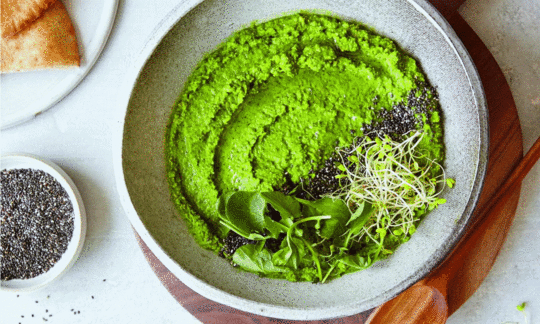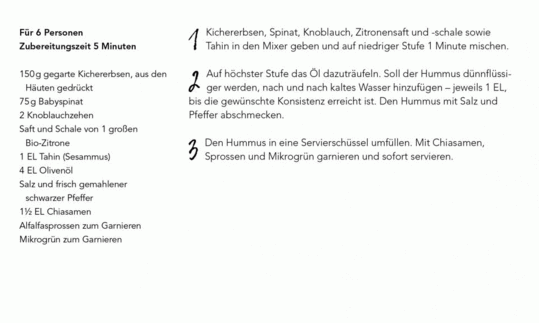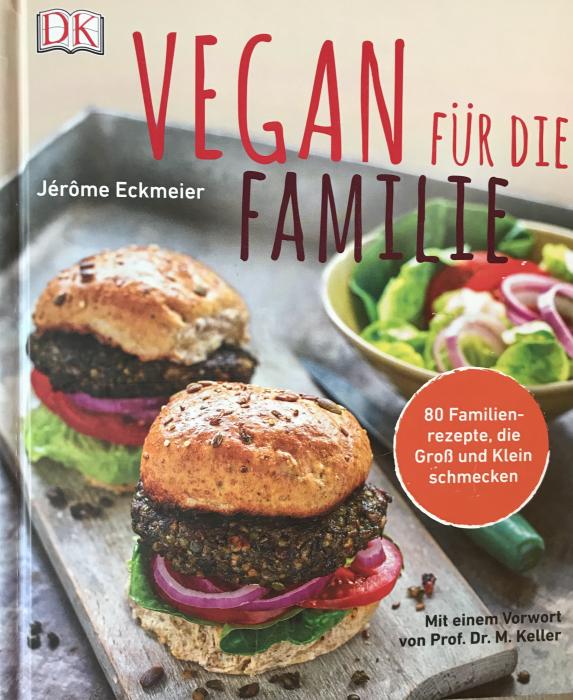Lemony Spinach Hummus with Tahini and Chia Seeds
vegan
Ingredients (for servings, )
| 5 ½ oz | Cooked chickpeas (organic?) |
| 2 ⅔ oz | Baby spinach |
| 2 cloves | Garlic (organic?) (0.21 oz) |
| 1 | Lemons, raw (limes, organic?) (2.0 oz) |
| 1 tbsp | Tahini (sesame butter, raw?, organic?) (0.53 oz) |
| 4 tbsp | Olive oil (cold pressed, raw?, organic?) (1.9 oz) |
| 1 dash | Table salt (table salt, raw?, organic?) (0.01 oz) |
| 1 dash | Black pepper (organic?, raw?) (0.00 oz) |
| 1 ½ tbsp | Chia (chia seeds), raw, organic? (0.28 oz) |
| 2 tbsp | Lucerne seeds, germinated, raw (Alfalfa, ~snail clover, organic?) (0.21 oz) |
Equipment
- blender
- grater
- citrus juicer (lemon squeezer)
- sieve
- canning jar (Weck jar, Mason jar)
Type of preparation
- chop or grind
- food preparation without heating
- blend
- squeeze
- strain
- season to taste
- remove the skin
- grate (shred)
Preparation
Preparation
Squeeze the cooked chickpeas out of their skins. Wash the spinach and peel the 2 garlic cloves. Wash the lemon, grate the peel and squeeze the juice.The author recommends using one large organic lemon for 6 servings.
Preparation of the spinach hummus
Place chickpeas, spinach, garlic cloves, lemon juice and zest and tahini in the blender and mix on low speed for 1 minute.Drizzle in the oil on high heat. If you want the hummus to be thinner, add cold water little by little - 1 tablespoon at a time until the desired consistency is reached. Season the hummus with salt and freshly ground black pepper.
Arranging and Serving
Transfer the lemony spinach hummus to a serving bowl. Garnish with chia seeds, microgreens and sprouts if desired and serve immediately.If you have any hummus left over, transfer it to a clean container (e.g. a mason jar), add a little oil to the surface to preserve it (it should form a thin protective film) and store it tightly closed in the refrigerator.
|
Nutritional Information per person
Convert per 100g
|
2000 kcal | |
|---|---|---|
| Energy | 143 kcal | 7.1% |
| Fat/Lipids | 11 g | 16.0% |
| Saturated Fats | 1.5 g | 7.6% |
| Carbohydrates (inc.dietary fiber) | 9.5 g | 3.5% |
| Sugars | 0.60 g | 0.7% |
| Fiber | 3.6 g | 14.5% |
| Protein/Albumin | 3.5 g | 6.9% |
| Cooking Salt (Na:39.7 mg) | 101 mg | 4.2% |
| Essential micronutrients with the highest proportions | per person | 2000 kcal | |
|---|---|---|---|
| Vit | Vitamin K | 66 µg | 88.0% |
| Vit | Vitamin B9, B11 (Folate, as the active form of folic acid) | 45 µg | 22.0% |
| Min | Manganese, Mn | 0.42 mg | 21.0% |
| Fat | Alpha-Linolenic acid; ALA; 18:3 omega-3 | 0.34 g | 17.0% |
| Vit | Vitamin E, as a-TEs | 1.9 mg | 16.0% |
| Fat | Linoleic acid; LA; 18:2 omega-6 | 1.6 g | 16.0% |
| Min | Copper, Cu | 0.14 mg | 14.0% |
| Prot | Tryptophan (Trp, W) | 0.03 g | 13.0% |
| Prot | Threonine (Thr, T, irreversibly transaminated) | 0.12 g | 13.0% |
| Prot | Isoleucine (Ile, I) | 0.16 g | 13.0% |
Detailed Nutritional Information per Person for this Recipe
The majority of the nutritional information comes from the USDA (US Department of Agriculture). This means that the information for natural products is often incomplete or only given within broader categories, whereas in most cases products made from these have more complete information displayed.
If we take flaxseed, for example, the important essential amino acid ALA (omega-3) is only included in an overarching category whereas for flaxseed oil ALA is listed specifically. In time, we will be able to change this, but it will require a lot of work. An “i” appears behind ingredients that have been adjusted and an explanation appears when you hover over this symbol.
For Erb Muesli, the original calculations resulted in 48 % of the daily requirement of ALA — but with the correction, we see that the muesli actually covers >100 % of the necessary recommendation for the omega-3 fatty acid ALA. Our goal is to eventually be able to compare the nutritional value of our recipes with those that are used in conventional western lifestyles.
| Essential fatty acids | per person | 2000 kcal |
|---|---|---|
| Alpha-Linolenic acid; ALA; 18:3 omega-3 | 0.34 g | 17.0% |
| Linoleic acid; LA; 18:2 omega-6 | 1.6 g | 16.0% |
| Essential amino acids | per person | 2000 kcal |
|---|---|---|
| Tryptophan (Trp, W) | 0.03 g | 13.0% |
| Threonine (Thr, T, irreversibly transaminated) | 0.12 g | 13.0% |
| Isoleucine (Ile, I) | 0.16 g | 13.0% |
| Lysine (Lys, K, irreversibly transaminated) | 0.20 g | 11.0% |
| Leucine (Leu, L) | 0.23 g | 9.0% |
| Phenylalanine (Phe, F) | 0.14 g | 9.0% |
| Valin (Val, V) | 0.15 g | 9.0% |
| Methionine (Met, M) | 0.04 g | 4.0% |
| Vitamins | per person | 2000 kcal |
|---|---|---|
| Vitamin K | 66 µg | 88.0% |
| Vitamin B9, B11 (Folate, as the active form of folic acid) | 45 µg | 22.0% |
| Vitamin E, as a-TEs | 1.9 mg | 16.0% |
| Vitamin C (ascorbic acid) | 9.4 mg | 12.0% |
| Vitamin B1 (Thiamine) | 0.10 mg | 9.0% |
| Vitamin A, as RAE | 62 µg | 8.0% |
| Vitamin B6 (pyridoxine) | 0.09 mg | 7.0% |
| Vitamin B3 (Niacin) | 0.84 mg | 5.0% |
| Vitamin B2 (Riboflavin) | 0.05 mg | 4.0% |
| Vitamin B5 (Pantothenic acid) | 0.12 mg | 2.0% |
| Vitamin B7 (Biotin, ex vitamin H) | 1.2 µg | 2.0% |
| Essential macroelements (macronutrients) | per person | 2000 kcal |
|---|---|---|
| Phosphorus, P | 83 mg | 12.0% |
| Magnesium, Mg | 33 mg | 9.0% |
| Potassium, K | 175 mg | 9.0% |
| Calcium, Ca | 41 mg | 5.0% |
| Sodium, Na | 40 mg | 5.0% |
| Essential trace elements (micronutrients) | per person | 2000 kcal |
|---|---|---|
| Manganese, Mn | 0.42 mg | 21.0% |
| Copper, Cu | 0.14 mg | 14.0% |
| Iron, Fe | 1.4 mg | 10.0% |
| Zinc, Zn | 0.62 mg | 6.0% |
| Selenium, Se | 1.9 µg | 3.0% |
| Iod, I (Jod, J) | 2.5 µg | 2.0% |
| Fluorine, F | 4.5 µg | < 0.1% |
Dorling Kindersley Verlag GmbH / Penguin Random House Gruppe, Jérôme Eckmeier
Raw recipes 9, Cooked recipes 68 (4)
Additional photos (9)
The recipe book "Vegan for the Family - 80 Family Recipes That Will Taste Good to All Ages" is specifically designed for everyday use and for newcomers to vegan cuisine.
Since this book is written in German, a description is omitted here. If you are interested, please switch to German in the menu.
The lemony spinach hummus with tahini and chia seeds is a nice, healthy alternative to traditional hummus.
Preparation time: The preparation time indicated does not include cooking the chickpeas.
Nutrient profile : According to GDA guidelines, one portion of this recipe covers almost the average daily requirement of vitamin K. Furthermore, it covers about ¼ of the requirement for manganese and folic acid and almost 20% of the requirement for vitamin C and copper. The recommended maximum ratio of omega-6 to omega-3 fatty acids of 5:1 is adhered to.
Chickpeas: Chickpeas are very high in protein, with an average of 20 g of protein per 100 g, making them a good addition to vegetables. Chickpeas are usually available dried or pre-cooked and preserved. While the preserved version is more convenient and saves time, the dried version, which you have to cook yourself, has the advantage of tasting much better. In addition, by cooking them at home you can also determine the degree of firmness yourself (canned chickpeas are often very soft, sometimes even mushy).
Spinach: Spinach ( Spinacia oleracea), also known as vegetable spinach or garden spinach, is rich in carotenoids, vitamins (especially vitamin K) and minerals. Although spinach contains a lot of oxalic acid (oxalate), eating raw spinach in large quantities is not harmful to health. Baby spinach, as used in this recipe, also has less oxalic acid than the older leaves. In large quantities, consuming foods that are high in oxalic acid can interfere with iron therapy, e.g. in the context of iron deficiency anemia. This is because oxalic acid makes it difficult for iron to be absorbed in the intestine.
Alfalfa: The (seed) alfalfa ( Medicago sativa), which belongs to the Fabaceae family, is also known as alfalfa, snail clover or everlasting clover. The germinated, low-calorie sprouts are among the most popular of their kind thanks to their mild, nutty taste. They are rich in protein (almost 10%) and fiber, but are primarily good for their vitamin K content. Just 100 grams cover more than 40% of the daily dose of the vitamin in question recommended by the EU Food Information Regulation, which is involved in coagulation, bone metabolism and vascular regeneration, among other things.
Tahini: The nutty-tasting sesame butter known as tahini is made from sesame seeds processed into a kind of paste. It is also available in raw form, where the sesame seeds are placed in water without being roasted, and in the commercially available roasted form.
Aquafaba: The cooking liquid from chickpeas, called aquafaba (whether you cook it yourself or use it from a can), can be used wonderfully as a vegan egg substitute for later use (see information under the ingredient) - so be sure to keep it. However, please note that the liquid from canned chickpeas is sometimes salted, which limits their use in desserts.
Buying preserved chickpeas: If you want to use preserved chickpeas, it is advisable to buy organic chickpeas. They are often processed more gently, but above all they contain fewer or no additives. Glass jars, which generally predominate in organic stores, are particularly recommended. These do not contain aluminum or BPA (bisphenol A) and are more environmentally friendly.
Nutrient overview and useful tips: In the nutrient tables above the recipe preparation you will find more information about the composition of this dish. Information on an optimal ratio of fatty acids and general information on common nutritional errors in vegan and raw diets can be found at the following link: Vegans often eat unhealthily. Avoidable nutritional errors.
Oil and omega-3 fatty acids: You can also use an oil other than the olive oil listed here. This not only influences the taste, but also the health-promoting components, depending on the amount and type of oil. Rapeseed oil, for example, contains up to three times the amount of polyunsaturated fatty acids and also has a more balanced composition in terms of essential fatty acids.






